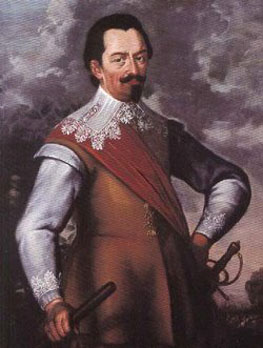
Heeresgeschichtliches Museum
In the War History Museum, they display various items: weapons, armor, and artifacts throughout the different major wars that Austria and specifically Vienna has been involved in.
17th Century
Vienna was involved in two wars: the 30 years war and the war with the Turks. The 30 Years War lasted from 1618-1648 and was mostly fought in central Europe. It started as a conflict among religious groups, specifically the Catholics and Protestants; however as the war continued on, it really became a war to balance powers in Europe. It was mainly an attempt by the French to make sure that the Habsburgs did not get too powerful, to ensure this the French sided with the Protestant Swedes. The war ended with the leader of the Swedes, Gustavus Adolphus. In the aftermath of the war, it is hard to identify a victor, since all involved parties were greatly hurt by the war, especially economically and no one country became very powerful.
The Ottomans were interested in expanding their empire to the west and wanted to obtain Vienna for its strategic position along the Danube. In July 1683, the Turkish troops marched to the walls of Vienna and laid siege on the city for the second time, led by Kara Mustafa. However thanks to the military might of Prince Eugene of Savoy, Polish troops, and the looming cold winter, the Ottomans were kicked out of Vienna, never to return again. During the period of the second Ottoman siege, there was a lot of fear among the citizens and imperial family in Vienna. They did not know if this siege was ever going to end and had very little understanding of the Ottomans and their military power.
 photo: courtesy of google images
photo: courtesy of google imagesAlbrecht von Wallenstein
Wallenstein was an important general of the 30 Years War. However in 1630 the authorities feared that he was becoming too powerful and they dismissed him from command. He was called back after a short while when the Swedes began to gain strength. In the end, he was suspected of treason and assassinated in 1634.

Battle of Lutzen by Peeter Snayers
The Swedish and German armies are depicted in the background and the Habsburg’s Imperial army is depicted in the foreground. Through this painting, historians can see the conditions of the 30 Years war. The terrible conditions are shown: disease, death, and cramped quarters.
Turkish army dress, weapons
In all of the items displayed in this museum, the Ottomans are depicted in a very barbaric manner. It is true however that the Ottomans used some “outdated” by effective weapons, namely bows and arrows, while the imperial army used gun powder and more advanced weapons.
World War I and the End of the Habsburg Monarchy
When the Archduke Franz Ferdinand, successor to the Habsburg throne, and his wife Sophia were assassinated in Sarajevo in 1914 by a nationalist group, the Black Hand, this ignited a series of events that eventually resulted in World War I. The Habsburg Empire placed the country of Serbia responsible for the death of Franz Ferdinand and waged war on them, however because of a web of complicated alliances it resulted in to a full fledged world war. The Austria-Hungary Empire did not do well in the trench warfare and had difficulties keeping its multinational empire cohesive. In the end, the empire began to dissolve and in November 1918, an armistice agreement was met, which resulted in the collapse of the empire.

Vehicle of Archduke Franz Ferdinand
This is the 4 cylinder, 30 horsepower car that the archduke was shot in. This was the second attempt on his life, he escaped the first one unscathed; however after being shot in Sarajevo, he eventually died, although not instantaneously. The bullet hole is still visible.

Uniform and Chaise
This is the uniform that Franz Ferdinand was shot in. The blood and bullet holes are still visible and also the incision that the doctor had to make into his uniform to remove the bullet. This is the chaise that the archduke spent the remaining moments of his life.
No comments:
Post a Comment